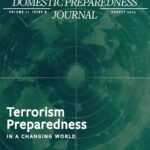Comprehensive emergency management in the United States was developed from the World War II and Cold War discipline of civil defense, but today, civil defense concepts, plans, and policy within comprehensive emergency management are practically non-existent. Despite a majority of Americans believing that the U.S. could become involved in a major conflict within the next 10 years, it is difficult to find war on an all-hazards list.
Leon Trotsky noted that “you may not be interested in war, but war is interested in you.” Many national security experts believe that U.S. adversaries are already making preparations for a future large-scale combat operation, which will include enemy actions in the homeland. It is time to update the National Preparedness System to include a national planning framework for civil defense that can “foster a shared understanding of our roles and responsibilities from the firehouse to the White House.”
Threats to the Homeland
The mutually assured destruction of nuclear war, which even today cannot be dismissed, has been considered so apocalyptic, so unsurvivable, that it is not worth preparing for. After decades of the Global War on Terrorism, American society has become used to the idea that non-nuclear war is something that the all-volunteer military goes overseas to fight. It has been more than 50 years since the draft ended, and 80 years since the entire nation—not just the military—went to war.
But in the cyber domain, Chinese advanced persistent threat groups have gained access to networks of critical infrastructure and are lurking there, or “living off the land,” perhaps waiting for the day when the People’s Republic of China decides to invade Taiwan before unleashing havoc on U.S. energy, communications, and transportation sectors. In the air and on the sea, Russian and Chinese aircraft and ships are regularly testing the nation’s border security. Physical actions within the homeland, including the penetration of sensitive sites and drone overflights of military facilities, may be tests and rehearsals for future actions.
Even when considered as a whole, most of these actions are unattributable and below the threshold of an act of war. But viewed through a military lens, future foes are conducting shaping actions, creating conditions for the success of a future decisive operation. Knowing that they will be unable to defeat U.S. military forces on the battlefield, adversaries will seek to cause chaos in the homeland to slow the deployment of U.S. forces overseas, disrupt supply chains that sustain combat operations, and undermine the nation’s will to fight. At the start of a major conflict, foes will attempt to overwhelm the capabilities of homeland security agencies with multiple, simultaneous critical incidents and present political leaders with competing crises and dilemmas.
For the national security enterprise to avoid being accused of another failure of imagination, as occurred in the aftermath of 9/11, the potential danger to the homeland needs to be acknowledged and acted upon at all levels of government before it is too late. It will require not just a whole-of-government but a whole-of-nation effort to prepare for a future large-scale combat operation. Because the next time the U.S. goes to war, war will be coming to the U.S.
Homeland Security Is Not Homeland Defense
The events of 9/11 were a tragic wake-up call and reminder about what happens when the homeland is not adequately secured. The subsequent creation of the homeland security enterprise has been successful at preventing a major terrorist attack in the U.S. over the last 23 years. In particular, the 22 agencies in the U.S. Department of Homeland Security (DHS) prevent terrorism by securing land and sea borders, screening air travelers, and performing other important tasks. DHS operates under authorities established by domestic law. Consequently, any individuals who may attempt to smuggle a biological pathogen into the country, for example, are treated as criminals and processed through the U.S. justice system.
The U.S. Department of Defense and military forces play many important roles in homeland security, but the military primarily operates in support of civil authorities. What distinguishes homeland defense from homeland security is that the president directs the military to defend the nation’s sovereignty by using military action in the homeland against an aggressor and by giving the military the lead in those situations. Instead of the homeland security enterprise stopping criminal terrorist activities, military actions will be necessary to defeat enemy combat operations.
Potential adversaries will attempt to blur the line between terrorism and military actions, but the following circumstances could lead to defending the homeland:
- The nation is officially—either through a declaration of war or of a national emergency—at war with a foreign power or powers.
- Enemy combatants (including domestic proxy forces) are carrying out attacks in the homeland that threaten the population, critical infrastructure, military resources or operations, or the ability to govern.
- Combatants are using military weapons not normally associated with criminal organizations, such as mortars, precision anti-armor weapons, or portable surface-to-air systems.
Even after a shift from security to defense, the Department of Defense will continue its other missions in support of civil authorities, but it will be more challenging to provide consequence management support in addition to homeland defense and deployment activities.
A Sixth Framework?
The U.S. has developed and refined a system for preparing for, responding to, and recovering from emergencies, no matter what the scale of the incident. The National Preparedness System utilizes five frameworks that create standard terms of reference and flexible structures to drive unified actions before, during, and after a human-caused emergency or a natural disaster from the municipal to the federal level. As noted earlier, war can and should be considered a hazard, but it is not mentioned specifically in any of the current frameworks.
The question is, how can civil preparedness and civil defense be incorporated into the National Preparedness System in preparation for the hazard of a large-scale combat operation? The current frameworks are flexible and adaptable, and there is integration between them. But the primary issue with the system framework is that there are no specific core capabilities that address homeland defense.
Developing a sixth framework (i.e., the “National Civil Defense Framework”) would
- Describe core capabilities needed to defend the homeland during war;
- Highlight necessary authorities;
- Provide guidance on civil preparedness;
- Align key roles and responsibilities for defending the homeland and delivering civil defense capabilities;
- Develop coordinating structures that will enable cooperation among stakeholders;
- Lay a foundation for further operational planning and coordination to synchronize defense efforts within the whole community and across the other mission areas, particularly prevention.
Civil Preparedness Is Emergency Preparedness
Considering the threat of Russian aggression on the North Atlantic Treaty Organization’s (NATO) eastern borders, NATO’s Secretary General Mark Rutte has been emphasizing the need for the alliance to adopt a “wartime mindset.” France recently announced plans to distribute a survival manual to households to help them prepare in case of an armed conflict, based on a similar Swedish pamphlet called In Case of Crisis or War.
Mailing such a pamphlet to every household in America is likely to raise anxiety rather than awareness. Creating a civil defense framework requires a deliberate whole-of-nation effort, and the emergency management community is a vital stakeholder in developing civil defense doctrine. At the federal level, emergency response planning must recognize the threat of a large-scale combat operation. The development of a civil defense framework will provide the momentum to start planning at the state, territory, tribal, and local levels, too. Such efforts may even influence more American households to prepare for an emergency. According to the 2024 National Household Survey on Disaster Preparedness, 68% of households had low preparedness efficacy (confidence in their ability to prepare and belief that taking action helps).
When war was raging in Europe and Asia in 1940, the United States trusted that the two great oceans and its friendly neighbors would provide a peaceful sanctuary for the nation. But President Franklin D. Roosevelt recognized that it was only a matter of time before the U.S. would be compelled to join the fight for freedom, and he began a series of initiatives to prepare the nation, including reestablishing the civil defense program. A case can be made that 2025 is looking more like 1940, but now the nation requires a 21st-century approach to defending the homeland by developing a framework and systems for civil preparedness and defense.

George M. Schwartz
Dr. George M. Schwartz is an associate professor at Immaculata University and has been the director of the undergraduate program in emergency management there since 2014. He is also a retired senior Army officer with more than 30 years of service overseas and in the homeland, including leading National Guard units during domestic response operations. During the past academic year, he was a visiting professor at the United States Army War College, conducting research on homeland defense and security issues.
- George M. Schwartzhttps://www.domesticpreparedness.com/author/george-m-schwartz
- George M. Schwartzhttps://www.domesticpreparedness.com/author/george-m-schwartz
- George M. Schwartzhttps://www.domesticpreparedness.com/author/george-m-schwartz
- George M. Schwartzhttps://www.domesticpreparedness.com/author/george-m-schwartz





